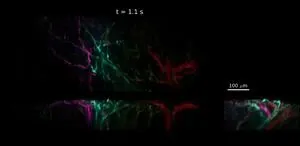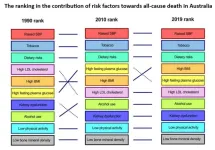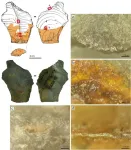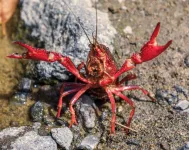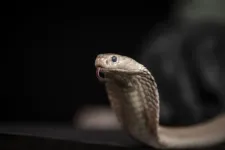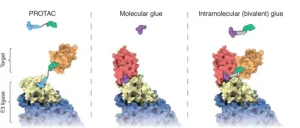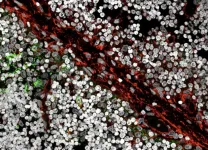(Press-News.org) BERKS, Pa. — The supermassive black hole in the center of the Milky Way is spinning so quickly it is warping the spacetime surrounding it into a shape that can look like a football, according to a new study using data from NASA’s Chandra X-ray Observatory and the U.S. National Science Foundation’s Karl G. Jansky Very Large Array (VLA). That football shape suggests the black hole is spinning at a substantial speed, which researchers estimated to be about 60% of its potential limit.
The work, led by Penn State Berks Professor of Physics Ruth Daly, was published in the Monthly Notices of the Royal Astronomical Society.
Astronomers call this giant black hole Sagittarius A* (Sgr A*). It is located about 26,000 light-years away from Earth in the center of the galaxy. To determine how quickly Sgr A* is spinning — one of its fundamental properties, along with mass — the researchers applied a method that uses X-ray and radio data to assess how material is flowing towards and away from the black hole. The method was developed and published by Daly in 2019 in The Astrophysical Journal.
“Our work may help settle the question of how fast our galaxy’s supermassive black hole is spinning,” Daly said. “Our results indicate that Sgr A* is spinning very rapidly, which is interesting and has far-reaching implications.”
The team found the angular velocity — the number of revolutions per second — of Sgr A*’s spin is about 60% of the maximum possible value, a limit set because material cannot travel faster than the speed of light.
Past estimations of Sgr A*’s speed have been made with different techniques and by other astronomers, with results ranging from no rotation at all to spinning at almost the maximum rate.
“This work, however, shows that this could change if the amount of material in the vicinity of Sgr A* increases,” Daly said.
As a black hole rotates, it pulls “spacetime” — the combination of time and the three dimensions of space — and nearby matter. The gravitational pull also squashes the spacetime, altering its shape depending on how it’s observed. Spacetime appears circular if the black hole is viewed from the top. From the side, however, the spacetime is shaped like a football. The faster the spin, the flatter the football.
The spin can also serve as an energy source, Daly said, if matter — such as gas or the remnants of a star that wanders too close — exists in the vicinity of the black hole. As the black hole spins, matter can escape in the form of narrow jets called collimated outflows. However, Sgr A* currently has limited nearby matter, so the black hole has been relatively quiet, with weakly collimated outflows, in recent millennia.
“A spinning black hole is like a rocket on the launch pad,” said Biny Sebastian, a co-author from the University of Manitoba in Winnipeg, Canada. “Once material gets close enough, it’s like someone has fueled the rocket and hit the ‘launch’ button.”
This means that in the future, if the properties of the matter and the magnetic field strength close to the black hole change, part of the enormous energy of the black hole’s spin could drive more powerful outflows. This source material could come from gas or from the remnants of a star torn apart by the black hole’s gravity if that star wanders too close to Sgr A*.
“Jets powered and collimated by a galaxy’s spinning central black hole can profoundly affect the gas supply for an entire galaxy, which affects how quickly and even whether stars can form,” said co-author Megan Donahue from Michigan State University. “The ‘Fermi bubbles’ seen in X-rays and gamma rays around our Milky Way’s black hole show the black hole was probably active in the past. Measuring the spin of our black hole is an important test of this scenario.”
Fermi bubbles refer to structures that emit gamma rays above and below the black hole that researchers have theorized resulted from prior massive outflows.
The researchers used the outflow method to determine the spin of Sgr A*. Daly’s approach incorporates consideration of the relationship between the spin of the black hole and its mass, the properties of the matter near the black hole and the outflow properties. The collimated outflow produces the radio waves, while the disk of gas surrounding the black hole emits X-rays. The researchers combined observational data from Chandra and the VLA with an independent estimate of the black hole’s mass from other telescopes to inform the outflow method and determine the black hole’s spin.
“We have a special view of Sgr A* because it is the nearest supermassive black hole to us,” said co-author Anan Lu from McGill University in Montreal, Canada. “Although it's quiet right now, our work shows that in the future it will give an incredibly powerful kick to surrounding matter. That might happen in a thousand or a million years, or it could happen in our lifetimes.”
In addition to those mentioned above, co-authors include Christopher O’Dea, University of Manitoba, and Daryl Haggard, McGill University.
NASA's Marshall Space Flight Center manages the Chandra program. The Smithsonian Astrophysical Observatory's Chandra X-ray Center controls science operations from Cambridge, Massachusetts, and flight operations from Burlington, Massachusetts.
Editor’s note: A version of this press release was originally published by NASA’s Marshall Space Flight Center.
END
Black hole at center of the Milky Way resembles a football
Researchers revealed that the black hole’s spinning speed could provide an ‘incredibly powerful kick’ to surrounding matter
2024-02-21
ELSE PRESS RELEASES FROM THIS DATE:
Stowers Institute Scientific Director Kausik Si receives coveted award from the Chan Zuckerberg Initiative
2024-02-21
KANSAS CITY, MO—February 21, 2024—The Chan Zuckerberg Initiative (CZI) has announced the awardees of their second cycle of Collaborative Pairs Pilot Project Awards, part of the CZI Neurodegeneration Challenge Network (NDCN).
Scientific Director Kausik Si, Ph.D., from the Stowers Institute for Medical Research will receive an award for the project titled, “Tuning memory by altering amyloids,” which will be conducted alongside Investigator Lukasz Joachimiak, Ph.D., from the University of Texas Southwestern.
The Collaborative Pairs Pilot Project Awards were launched in 2018 to investigate unsolved mysteries ...
Raised blood pressure is the leading risk factor for death in Australia
2024-02-21
Raised blood pressure has been the leading risk factor for death in Australia for the past three decades, according to a study published February 21, 2024, in the open-access journal PLOS ONE led by Alta Schutte and Xiaoyue Xu from The George Institute for Global Health and UNSW, Sydney, with colleagues across Australia. It is also the main contributor to deaths from cardiovascular disease (CVD) specifically.
Raised blood pressure has long been recognized as a contributing factor to CVD and death, but is not always prioritized in national health plans. In this study, researchers focused on Australia, which lags ...
Biodiversity footprints for 151 dishes from around the world show that dishes with a larger impact on biodiversity tend to be meat, legume, or rice-based
2024-02-21
Dishes like Brazilian steak and Indian kidney bean curry have an especially large biodiversity footprint, or impact on biodiversity, according to a study published February 21, 2024 in the open-access journal PLOS ONE by Elissa Cheng from the National University of Singapore, Singapore, and colleagues.
Food choices can have significant environmental impacts. Previous research has begun to develop datasets that identify the encroachment of specific crops on the ranges of birds, mammals and amphibians. Based on these data, Cheng and colleagues estimated how 151 ...
Did neanderthals use glue? Researchers find evidence that sticks
2024-02-21
Neanderthals created stone tools held together by a multi-component adhesive, a team of scientists has discovered. Its findings, which are the earliest evidence of a complex adhesive in Europe, suggest these predecessors to modern humans had a higher level of cognition and cultural development than previously thought.
The work, reported in the journal Science Advances, included researchers from New York University, the University of Tübingen, and the National Museums in Berlin.
“These ...
Severe maternal grief associated with increased risk of heart failure in child
2024-02-21
Prenatal stress is a potential risk factor for cardiovascular disease in offspring later in life. In a new study published today in JACC: Heart Failure, maternal loss of a partner or child shortly before or during pregnancy was found to be associated with increased risk of heart failure up to middle-age in the child.
Heart failure is a condition in which the heart cannot pump enough oxygen-rich blood to the organs, causing a variety of symptoms. Heart failure cannot be cured but symptoms can be treated and managed to improve quality and length of life. According to the World Heart Federation, more than 64 million people worldwide have heart failure.
According ...
Increasingly similar or different? Centuries-long analysis suggests biodiversity is differentiating and homogenizing to a comparable extent
2024-02-21
The tendency of communities and the species within them to become more similar or more distinct across landscapes – biotic homogenisation and differentiation – are approximately balanced, according to a new study published in Science Advances.
Led by researchers at the German Centre for Integrative Biodiversity Research (iDiv) and the Martin Luther University Halle-Wittenberg (MLU), the researchers analysed 527 datasets collected from ecosystems like grasslands, shrublands, and coral reefs as far back as 500 years ago. The analysis is the first of its kind to provide ...
Long COVID linked to persistently high levels of inflammatory protein: a potential biomarker and target for treatments
2024-02-21
SARS-CoV-2 triggers the production of the antiviral protein IFN-γ, which is associated with fatigue, muscle ache and depression. New research shows that in Long COVID patients, IFN-y production persists until symptoms improve, highlighting a potential biomarker and a target for therapies.
A University of Cambridge-led study identifies the protein interferon gamma (IFN-γ) as a potential biomarker for Long COVID fatigue and highlights an immunological mechanism underlying the disease, which could pave the way for the development ...
Snaking toward a universal antivenom
2024-02-21
LA JOLLA, CA—Scripps Research scientists have developed an antibody that can block the effects of lethal toxins in the venoms of a wide variety of snakes found throughout Africa, Asia and Australia.
The antibody, which protected mice from the normally deadly venom of snakes including black mambas and king cobras, is described on February 21, 2024, in Science Translational Medicine. The new research used forms of the toxins produced in the laboratory to screen billions of different human antibodies and identify one that can block the toxins’ activity. It represents a large step toward a universal ...
New system triggers cellular waste disposal
2024-02-21
Living cells resemble highly organized small towns - in addition to energy production, transportation systems, and construction, cells also require efficient waste disposal. Most proteins, which shape and sustain cellular function, have only a limited half-life and must eventually be disposed of, along with defective and unwanted proteins. This vital task falls upon specialized enzymes known as ubiquitin ligases, which tag obsolete proteins for degradation, guiding them to the cellular recycling center, ...
Possible trigger for autoimmune diseases discovered : B cells teach T cells which targets must not be attacked
2024-02-21
Immune cells must learn not to attack the body itself. A team of researchers from the Technical University of Munich (TUM) and the Ludwig Maximilian University of Munich (LMU) has discovered a previously unknown mechanism behind this: other immune cells, the B cells, contribute to the "training" of the T cells in the thymus gland. If this process fails, autoimmune diseases can develop. The study confirms this for Neuromyelitis optica, a disease similar to Multiple Sclerosis. Other autoimmune diseases may be linked to the failure ...
LAST 30 PRESS RELEASES:
Sleeping in on weekends may help boost teens’ mental health
Study: Teens use cellphones for an hour a day at school
After more than two years of war, Palestinian children are hungry, denied education and “like the living dead”
The untold story of life with Prader-Willi syndrome - according to the siblings who live it
How the parasite that ‘gave up sex’ found more hosts – and why its victory won’t last
When is it time to jump? The boiling frog problem of AI use in physics education
Twitter data reveals partisan divide in understanding why pollen season's getting worse
AI is quick but risky for updating old software
Revolutionizing biosecurity: new multi-omics framework to transform invasive species management
From ancient herb to modern medicine: new review unveils the multi-targeted healing potential of Borago officinalis
Building a global scientific community: Biological Diversity Journal announces dual recruitment of Editorial Board and Youth Editorial Board members
Microbes that break down antibiotics help protect ecosystems under drug pollution
Smart biochar that remembers pollutants offers a new way to clean water and recycle biomass
Rice genes matter more than domestication in shaping plant microbiomes
Ticking time bomb: Some farmers report as many as 70 tick encounters over a 6-month period
Turning garden and crop waste into plastics
Scientists discover ‘platypus galaxies’ in the early universe
Seeing thyroid cancer in a new light: when AI meets label-free imaging in the operating room
Neutrophil-to-lymphocyte ratio may aid risk stratification in depressive disorder
2026 Seismological Society of America Annual Meeting
AI-powered ECG analysis offers promising path for early detection of chronic obstructive pulmonary disease, says Mount Sinai researchers
GIMM uncovers flaws in lab-grown heart cells and paves the way for improved treatments
Cracking the evolutionary code of sleep
Medications could help the aging brain cope with surgery, memory impairment
Back pain linked to worse sleep years later in men over 65, according to study
CDC urges ‘shared decision-making’ on some childhood vaccines; many unclear about what that means
New research finds that an ‘equal treatment’ approach to economic opportunity advertising can backfire
Researchers create shape-shifting, self-navigating microparticles
Science army mobilizes to map US soil microbiome
Researchers develop new tools to turn grain crops into biosensors
[Press-News.org] Black hole at center of the Milky Way resembles a footballResearchers revealed that the black hole’s spinning speed could provide an ‘incredibly powerful kick’ to surrounding matter


